Cite this document
(Managing Knowledge and Information Systems Assessment Case Study, n.d.)
Managing Knowledge and Information Systems Assessment Case Study. https://studentshare.org/management/1873475-managing-knowledge-and-information-systems-assessment
Managing Knowledge and Information Systems Assessment Case Study. https://studentshare.org/management/1873475-managing-knowledge-and-information-systems-assessment
(Managing Knowledge and Information Systems Assessment Case Study)
Managing Knowledge and Information Systems Assessment Case Study. https://studentshare.org/management/1873475-managing-knowledge-and-information-systems-assessment.
Managing Knowledge and Information Systems Assessment Case Study. https://studentshare.org/management/1873475-managing-knowledge-and-information-systems-assessment.
“Managing Knowledge and Information Systems Assessment Case Study”. https://studentshare.org/management/1873475-managing-knowledge-and-information-systems-assessment.


